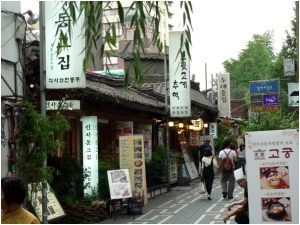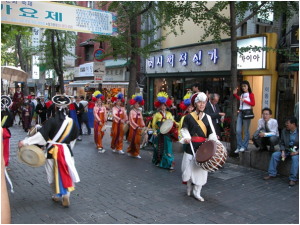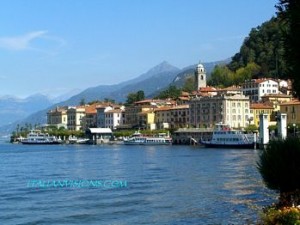Insa-dong (인사동): A must-see in Seoul, Korea
Insa-dong (인사동) is a must for Seoul tourist. To experience the traditional culture of Korea while staying in Seoul, visit Insa-dong. Insa-dong Street is one of the most memorable landmarks to represent you Korean traditional crafts and culture. With art galleries, traditional craft stores, antique art shops, traditional tea cafes and restaurants, it should be everything for visitors wanting to experience real Korean traditions. Especially, stores in Insa-dong are good for a wide kind of antiques-old paintings, antique furniture, ceramics, paper crafts, hanbok (한복/ traditional clothing), hanji (한지, traditional paper), and folk crafts can all be found in abundance.
Insa-dong Street stretches over 700 metres between the Anguk-dong Rotary (안국동 로터리) and Tapgol Park (탑골 공원). It is a quite long street. The art galleries (Insa Art Gallery, Dong Duk Art Gallery, Gana Art Space, Insa Art Centre…) in this area also make Insa-dong ideal place as a Korean cultural attraction. In 1999, Queen Elizabeth II visited the area and expressed deep admiration for the hanbok(한복/ Korea’s traditional dress) and for Korean pottery in particular. On weekends, the street is vehicle-free and flea markets are set up. Travelers from abroad also join the flea market with various goods from all over the world. So you could enjoy multicultural goods and events there.
Insa-dong creates unique atmosphere which is mixed up Korean traditions and young energy. Do not miss souvenir shops in Insa-dong. You could purchase Korean traditional souvenirs for your family and friends at a reasonable price. You can have help from the Insa-dong Information Centre (Tel: 82-2-737-7890) located 100m from Ssamjigil (쌈지길) toward Jogyesa Temple (조계사). The centre provides tourism information, interpretation services and free internet access.
By Sarah Yong (Korean teacher)
Some stories about our Japanese Courses 9
Hi everyone,皆さん、おげんきですか。
My Japanese classes and lesson include the following features. We had activities of speaking, reading, listening, writing, (esp. in group lessons) making and performing dialogues or speech with use of the course book, “Genki 1”, its grammar and vocab. of the Unit taught and its Workbook. Some students (esp. in the class of Beginners 1) made and memorized for one’s long speech or dialogue and that was very impressive.
As for reading and increase of vocab., grammar and plain forms, I read (and asked students read partly) a children’s books written in Japanese. The books have many colorful, informative, natural and beautiful photos and useful phrases, plain forms and other vocab. One was a book of “mochitsuki” (rice cake making by pounding cooked rice and the practice is yearly and nationally seen and practiced as Japanese people’s family/community activity late in December, before the New Year’s arrival. The book has details of the activities and scientific analysis of rice that is used for “mochitsuki”, which differs from ordinary rice used for daily meals in Japan. Also I read a book on “shimarisu” (stripe squirrels in Japan) to classes.
In most of all classes except the Intermediate 1, I showed the videos of “Wakuwaku Hiragana”, vol, 1 and 2. They have great presentations while introducing stroke orders, vocab. things that the script can be related in shape, many words that the script is used for, lovely animations, music and humors. Very suitable for anyone to watch and improve in writing those letters and increase vocab.
I taught Japanese “rajio-taisoo” (NHK’s daily radio exercise program, its physical exercise, cassette tape) to classes. (I’d taught this in Japanese classes many times in the past and many students, both children and adults enjoyed that.) Japanese people are expert of consistency, in many ways. The NHK radio program must have been on every morning for over half of a century and practiced in all primary schools and many other places (including car manufacturers every morning as the corporate activity) throughout Japan. My students of SLS responded to the tape and exercise, so I will continue having that activity occasionally in future too.
The class of Intermediate 1 (and newly started Beginners 2) are using “Kanji-no Hon” (by K. Aitchson, 2001, MacMillan) for Kanji acquisition. New students of Beginners 2 expressed that they wish to start Kanji instead of waiting for that until they reach the Pre-Intermediate 1. So, the class will have Kanji learning occasionally.
Beginners 1 that finished recently and those students (plus new students) started Beginners 2 recently. Those who finished and had my exam (that included Listening Test) did greatly with very impressive performance/attitude. Many congratulations to them!
Regarding culture, society and nature of Japan in recent media news and other resources used, as before, I showed a dvd, “Pilot Guides – Tokyo” (Tokyo City Guide) presented by highly recognized British presenter, Ian Wright, to new classes or students.
In addition, I informed of the article “High and mighty small” by L. Slattery, Wish, The Australian (4.5.12). That is about 2 distinctive and creative architects of Japan. One, Shigeru Yoshiko is the architect/designer of the world’s tallest media tower, Tokyo Sky Tree and the master of making the tall building. The other is Koji Tsutsui. He is the master of the small. He designed InBetween House near to Tokyo and who was a guest speaker at the conference in Australian Inst. of Architects in Brisbane last month (p. 48). Together they represent two faces of Japanese architecture (p. 48). Fascinating people and works!
Also, I reported and showed many great news and pictures from Japan that are in a magazine Jenta (25.5). They include the following. Aoi Festival in Kyoto in which 500 participants wear the Heian period (794-1185) costumes of noble people with carts etc. And Honda’s new personal mobility device (kind of chair and vehicle) and car navigation displays information shown on windshield that is amazing/smart technology that can appear in a Hollywood movie!). The magazine also shows or describes the historical side of Japanese people’s favorite, “onsen” in depth and the pictures, a 73-year-old Ms Tamae Watanabe who conquered Mt. Everest as the world’s oldest female, and information of many gorgeous natural mountains, waterfall, the village of the Edo Period style in Nagano etc.
Japanese Teacher, Toshiko Jackson
4.6.12
Learning Italian: Cultural Heritage
Lake Como
Italian language is spoken by over 70 million of people living in Italy but it is alive across the world thanks to other 70 million of Italians living abroad (especially in America and Australia). We could say there is “another Italy outside Italy”.
In Australia there are many people with Italian origins (about 200.000 people who are now in Australia were born in Italy; about 850.000 were born in here but speak Italian as second language at home) and many of them would like their children/grandchildren to carry on their language, culture and tradition.
Somehow Italian language and culture is a part of Australia and nowadays Italian is one of the most spoken languages in this country, too. In schools it is the second most taught language after Chinese. It is a heritage to be carried on and to be maintained.
Italians brought an important contribution to Australia: they came here to work but in the meanwhile they were able to export their food, their way of constructing buildings, their style.
The so called “made in Italy” is famous all over the world. And learning Italian is a way to go through it and discover the beauty of one of the oldest language ever.
• European culture and history
• Italian sport
• Italian music (opera)
• Italian fashion
• Italian food
• Italian art
• The beauty of a language
• The importance of learning a second language (different from English family)
• It is easier to learn a similar language (French, Spanish etc.)
• Italian cinema






Latest Comments